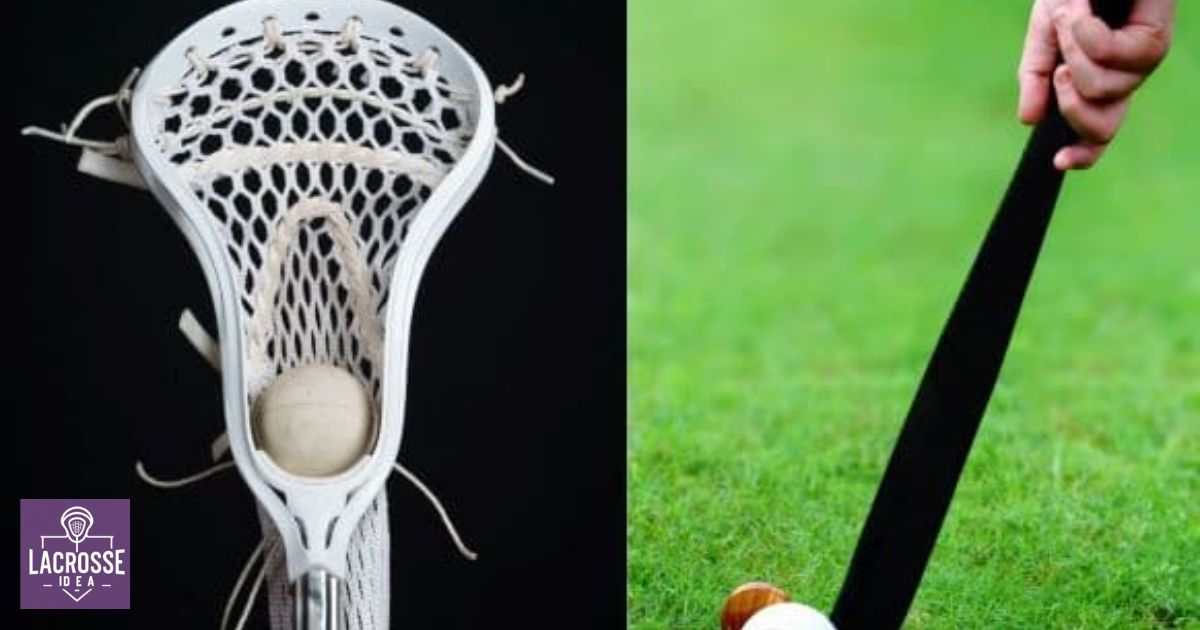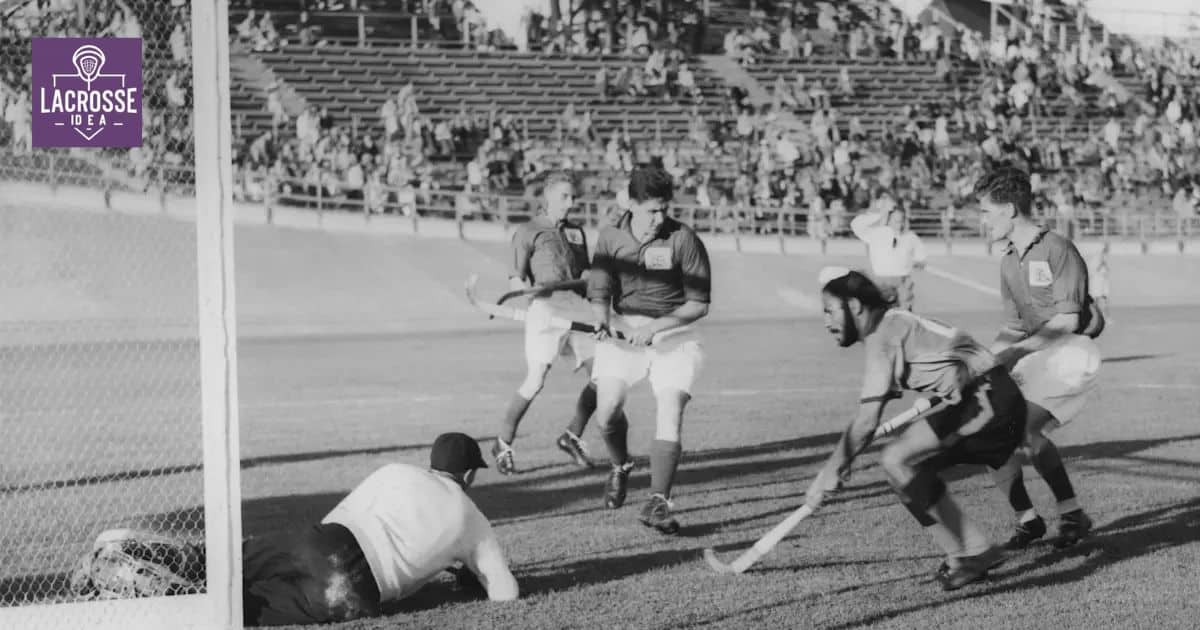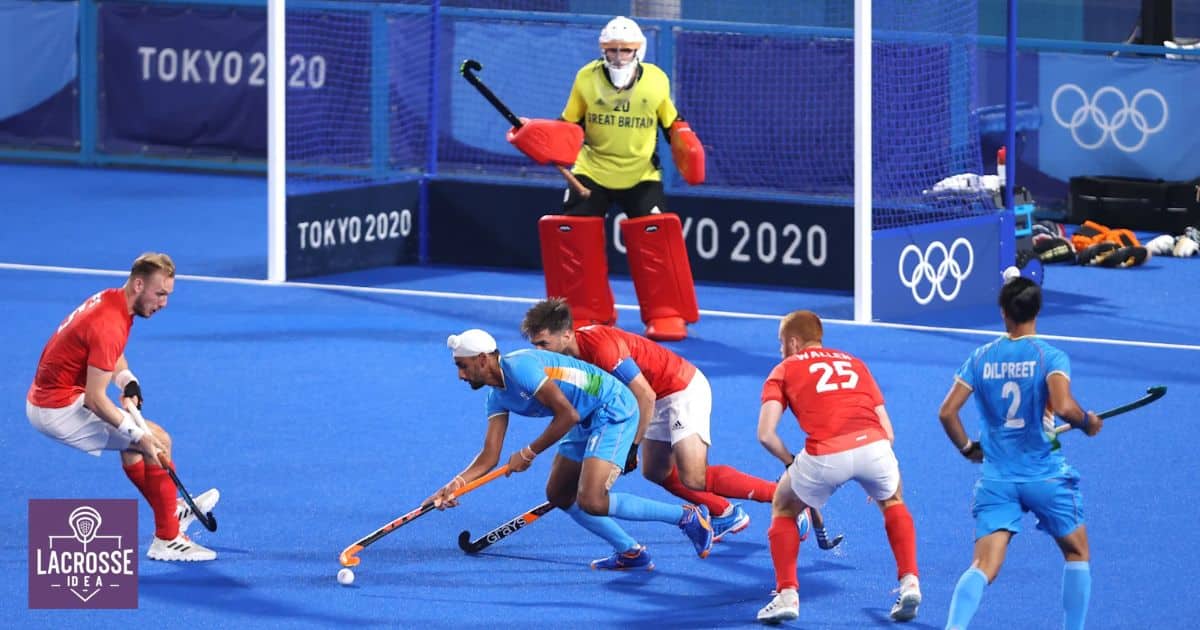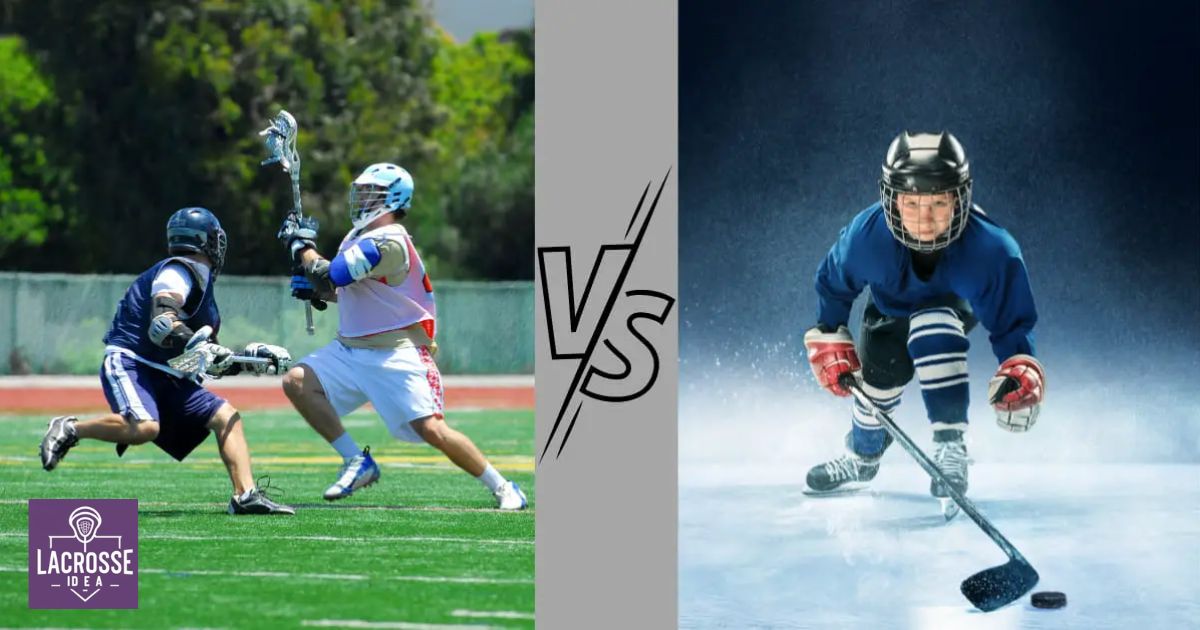Imagine stepping onto a lush green field, surrounded by the echoes of cheering crowds. Two sports, both demanding skill, camaraderie, and tenacity, stand apart. Field hockey and lacrosse, each with their unique histories and origins, captivate players and fans alike. As we delve into the differences between these captivating sports, we uncover the intricacies of their playing surfaces, equipment, objectives, and more. Join us on this journey as we explore the world of field hockey and lacrosse, where passion and determination collide.
Key Takeaways
- Field hockey has ancient origins dating back to ancient Egypt and Persia, while lacrosse has its origins in Native American cultures, particularly the Iroquois people.
- Field hockey is played on a smaller field than lacrosse, measuring 91.4 meters long and 55 meters wide, while lacrosse is played on a field measuring 110 yards long and 60 yards wide.
- The equipment used in field hockey and lacrosse differs, with field hockey players wearing shin guards, mouthguards, and helmets, while lacrosse players wear helmets, shoulder pads, and gloves.
- The objective of field hockey is to score goals by maneuvering the ball into the opponent’s net using a stick, while in lacrosse, the objective is to shoot a small rubber ball into the opponent’s net using a lacrosse stick.
History And Origins
One significant difference between field hockey and lacrosse lies in their respective histories and origins. Both sports have evolved over time, but their paths of evolution have been distinct. Field hockey, often considered one of the oldest sports in the world, has ancient origins dating back to ancient Egypt and Persia. It has evolved from its early forms to the standardized game we know today, with organized rules and international competitions.
On the other hand, lacrosse has its origins in Native American cultures, particularly the Iroquois people. The sport has a rich history and deep cultural significance, with traditional versions of the game being played for centuries. Lacrosse has also undergone evolution and adaptation, as it was introduced to European settlers and developed into the modern field lacrosse and box lacrosse we see today.
Playing Surface
The playing surface is a key distinction between field hockey and lacrosse. Both sports have specific field dimensions and game rules that are designed to optimize gameplay and ensure fairness. In field hockey, the playing surface is usually a grass or artificial turf field that measures 91.4 meters long and 55 meters wide. The field is marked with lines and circles to indicate specific areas for gameplay, such as the shooting circle and the penalty corner area.
On the other hand, lacrosse is typically played on a field that measures 110 yards long and 60 yards wide. The field is divided into different zones, including the offensive and defensive zones, and is marked with lines to indicate boundaries and restraining areas. The size and layout of the playing surface in each sport greatly influence the strategies and dynamics of the game.
Equipment
When comparing field hockey and lacrosse, the equipment used by players is another notable difference between the two sports. In field hockey, players wear protective gear to ensure safety during the game. This includes shin guards, mouthguards, and helmets, which provide a sense of security and belonging to the players. On the other hand, lacrosse players have a different set of equipment. They wear helmets, shoulder pads, and gloves to protect themselves from the physical nature of the sport. These protective gears are essential in creating a sense of belonging and confidence among lacrosse players.
Additionally, the stick design also differs between the two sports. Field hockey sticks have a curved end, allowing players to control the ball better, while lacrosse sticks have a deeper pocket, enabling players to catch and cradle the ball effectively. The differences in stick design emphasize the uniqueness of each sport and create a sense of identity for its players.
Objective Of The Game
With the equipment differences established, it is important to examine the distinctive objectives of the game in field hockey and lacrosse. In field hockey, the objective is to score goals by maneuvering the ball into the opponent’s net using a stick. The game rules dictate that the ball must be continuously pushed or hit with the stick, and players can only use one side of the stick to make contact with the ball.
On the other hand, the objective of lacrosse is to score goals by shooting a small rubber ball into the opponent’s net using a lacrosse stick. The game rules allow players to carry, pass, and shoot the ball using the stick’s netted pocket. Offensive strategies in field hockey involve creating passing lanes, executing well-coordinated attacks, and utilizing set plays, while in lacrosse, offensive strategies focus on ball movement, player positioning, and creating scoring opportunities through agility and teamwork.
Number Of Players
When comparing field hockey and lacrosse, one of the key differences lies in the number of players on each team. Field hockey typically consists of 11 players per team, while lacrosse has 10 players per team. This discrepancy in team size affects player positioning and overall strategy in both sports.
Team Size Differences
The team size differs between field hockey and lacrosse. In field hockey, each team consists of 11 players, while in lacrosse, each team has 10 players. These team size variations have a significant impact on gameplay, creating unique dynamics and strategies for each sport.
Sub-lists to evoke emotion in the audience:
- Field hockey’s larger team size allows for more player interactions and a greater sense of camaraderie on the field. This fosters a strong sense of belonging and teamwork among teammates, creating a supportive and united environment.
- With more players on the field, field hockey requires efficient coordination and communication among teammates. This fosters a sense of unity and belonging, as players work together towards a common goal.
- Lacrosse’s smaller team size promotes a faster-paced and more individualistic style of play. This can create an intense and competitive atmosphere, where players strive to showcase their skills and make a significant impact on the game.
- The smaller team size in lacrosse allows for increased maneuverability and agility. This evokes a sense of excitement and belonging, as players rely on their individual abilities to contribute to the team’s success.
With the understanding of team size differences, let’s now explore the variations in player positioning.
Player Positioning Variations
How does the difference in team size between field hockey and lacrosse impact player positioning? The variation in team size between field hockey and lacrosse leads to significant differences in player positioning on the field. In field hockey, each team has 11 players, while in lacrosse, the number of players per team is typically 10. This difference affects both defensive and offensive strategies employed by the teams. In field hockey, with the additional player, defensive strategies may focus on marking opponents more closely and creating a strong defensive structure.
On the other hand, in lacrosse, with one less player, defensive strategies may prioritize communication and quick transitions to prevent scoring opportunities. Similarly, offensive strategies in field hockey may involve creating passing lanes and utilizing the extra player, while in lacrosse, quick ball movement and effective ball control become crucial. Understanding these variations in player positioning is essential to excel in both sports.
Now, let’s explore how the scoring system differs between field hockey and lacrosse.
Scoring System
The scoring system is an essential aspect of both field hockey and lacrosse. In field hockey scoring, a goal is worth one point, and the team with the most points at the end of the game wins. On the other hand, in lacrosse scoring, the value of a goal varies, depending on whether it is a field goal or a goal scored during a power play. Understanding the different scoring techniques and the impact of penalties on scoring is crucial in both sports.
Goal Value Comparison
With regards to the scoring system, there is a significant difference in the value assigned to goals in field hockey and lacrosse. This difference has a direct impact on the offensive strategies employed by players in these sports. In field hockey, a goal is worth one point, while in lacrosse, a goal is worth one point for field goals and two points for shots taken outside the designated arc. This difference in goal value creates a sense of excitement and anticipation among the players and the audience.
In field hockey, the emphasis is on consistent ball movement and creating opportunities near the goal, while in lacrosse, players may take more risks and attempt shots from further distances to maximize their scoring potential. Understanding the goal value comparison is essential to grasp the nuances of offensive strategies in both sports. Moving forward, let’s delve into the scoring techniques explained.
Scoring Techniques Explained
To understand the scoring techniques in both sports, it is important to examine the unique scoring systems of field hockey and lacrosse. In field hockey, a goal is scored when the ball is successfully hit into the opponent’s goal using a hockey stick. Each goal is worth one point. On the other hand, in lacrosse, there are different ways to score.
A goal is scored when the ball is thrown or shot into the opponent’s goal using the lacrosse stick. Each goal is worth one point, but there are additional ways to score. In lacrosse, a player can score by shooting the ball into the goal or by hitting the ball into the goal with the stick. Additionally, if the goalie leaves the crease, the opposing team can score by shooting the ball into the unguarded goal.
The goalie plays a crucial role in both sports, as they are responsible for preventing the opposing team from scoring. In field hockey, the goalie uses a padded glove to block shots, while in lacrosse, the goalie uses a larger stick and wears additional protective equipment. Overall, while both sports have similar scoring systems, lacrosse offers more opportunities to score through different techniques and situations.
Penalty Impact On Scoring
Penalties in both field hockey and lacrosse have a significant impact on the scoring system. The effectiveness of penalty shots can make or break a team’s chances of scoring. In field hockey, penalty shots are awarded when a foul occurs inside the shooting circle, giving the attacking team a one-on-one opportunity against the goalkeeper.
The pressure is immense, as the success of the penalty shot can swing the momentum in favor of the team taking it. On the other hand, in lacrosse, penalty shots are called when a major foul is committed, granting the offense an unimpeded shot on goal. The outcome of these penalty shots can determine the final score, adding to the suspense and excitement of the game.
Additionally, the impact of penalty cards on team performance cannot be underestimated. A team that receives multiple penalty cards can find themselves at a numerical disadvantage, making it harder to defend and score. The presence of penalty cards adds an element of discipline and control to the game, making it crucial for players to stay within the rules and regulations.
Game Duration
The game duration in both field hockey and lacrosse varies depending on different factors. In field hockey, the length of the game typically ranges from 60 to 70 minutes, divided into two halves. However, the exact duration may vary based on the level of play and specific competition rules. The game pace in field hockey can be fast, with quick transitions and continuous play.
On the other hand, lacrosse games are generally shorter, lasting around 60 minutes. Lacrosse matches are divided into four quarters, each lasting 15 minutes. Similar to field hockey, the game duration can be influenced by the level of play and competition rules. The game pace in lacrosse can also be fast, with intense action and frequent scoring opportunities. Despite some rule differences, both field hockey and lacrosse offer exciting and competitive game durations for players and spectators.
Physical Contact
Engaging in physical contact is an integral part of both field hockey and lacrosse. However, there are some differences in the level of physicality and the rules surrounding contact in these two sports. In field hockey, players can use their bodies to block opponents and gain possession of the ball. While physical contact is allowed, it is important to note that excessive force is penalized, aiming to minimize the risk of injuries.
On the other hand, lacrosse is known for its physical nature, with players frequently checking and body-checking opponents to dispossess them. This higher level of physicality increases the risk of injuries, making protective gear such as helmets, gloves, and shoulder pads necessary.
Popular Leagues And Tournaments
One notable aspect to consider when comparing field hockey and lacrosse is the presence of popular leagues and tournaments in each sport. These leagues and tournaments play a vital role in the overall development of players and contribute to the competitive level and skill requirements of the game.
In field hockey, some of the most prestigious leagues and tournaments include the FIH Pro League, the Hockey World Cup, and the Champions Trophy. These events provide players with opportunities to showcase their skills on an international stage and compete against the best teams in the world. The impact on player development is immense, as they gain invaluable experience and exposure to different playing styles.
Similarly, in lacrosse, the Premier Lacrosse League (PLL) and Major League Lacrosse (MLL) are two prominent professional leagues. These leagues attract top-level players and offer a high level of competition. Additionally, international tournaments such as the FIL World Lacrosse Championships and the European Lacrosse Championships provide players with the chance to represent their countries and further enhance their skills.
Overall, the presence of popular leagues and tournaments in both field hockey and lacrosse greatly impacts player development and contributes to the competitive level and skill requirements of the sports.
| Field Hockey | Lacrosse |
|---|---|
| FIH Pro League | Premier Lacrosse League (PLL) |
| Hockey World Cup | Major League Lacrosse (MLL) |
| Champions Trophy | FIL World Lacrosse Championships |
| European Lacrosse Championships |
Frequently Asked Questions
Are There Any Specific Rules Regarding Player Substitutions in Field Hockey and Lacrosse?
Player substitution rules in both field hockey and lacrosse are specific to each sport. In field hockey, substitutions are allowed at any time and do not have an impact on player fouls. In lacrosse, substitutions can only occur during specific stoppages and player fouls can result in temporary suspensions.
What Are the Different Positions in Field Hockey and Lacrosse, and What Are Their Respective Roles?
In both field hockey and lacrosse, there are various positions that players assume, each with their own distinct roles on the field. These positions dictate the responsibilities and duties of players during gameplay.
Is There a Difference in the Level of Physicality Between Field Hockey and Lacrosse?
There is a difference in the level of physicality between field hockey and lacrosse. The impact of equipment, such as sticks and protective gear, can influence the intensity of contact. Furthermore, comparing injury rates can provide insight into the relative physical demands of each sport.
Are There Any Specific Penalties or Fouls That Can Result in a Player Being Sent off in Field Hockey and Lacrosse?
In field hockey and lacrosse, penalties and fouls play a significant role in regulating player conduct. How these infractions are enforced and the consequences of being sent off can vary, but they both aim to maintain fairness and sportsmanship on the field.
Can You Briefly Explain the Basic Strategies or Tactics Commonly Employed in Field Hockey and Lacrosse?
In field hockey, basic strategies involve creating passing lanes, maintaining possession, and executing well-coordinated attacks. Lacrosse employs strategies such as setting picks, executing dodges, and creating scoring opportunities. Both sports have rules regarding player substitutions, positions, roles, physicality, and penalties resulting in player ejections.
Conclusion
In conclusion, field hockey and lacrosse are both popular sports with distinct histories, playing surfaces, and equipment. While field hockey is played on a grass or artificial turf, lacrosse is played on a field or an indoor arena. The objective of the game and the number of players also differ between the two sports.
Additionally, field hockey has a scoring system based on goals, while lacrosse focuses on scoring points. Overall, field hockey and lacrosse offer unique experiences for athletes and fans alike, making them exciting and engaging sports to watch and play. As the saying goes, “Different strokes for different folks.”









